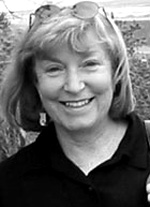
Close Read
Barbara Crooker
is the author of two poetry collections, Radiance and Line Dance, both from Word Press. Her journal credits include Yankee, Smartish Pace, The Beloit Poetry Journal, Nimrod, and The Denver Quarterly. Among her awards are three creative writing fellowships from the Pennsylvania Council on the Arts, the 2004 W.B. Yeats Society of New York Award, and the 2003 Thomas Merton Poetry of the Sacred Award (selected by Stanley Kunitz). Barbara lives in rural northeastern Pennsylvania, with her husband and son, who has autism. —Back to Orsorum Contents/Issue Links— |
Luci Shaw’s “Villanelle for a season’s ending”by Barbara Crooker
Villanelle for a season’s ending
Autumn is here, and summer will not stay. Luci Shaw is an interesting and complex poet who publishes widely in the kind of spiritual/Christian journals where we find writers like Kathleen Norris, Anne LaMott, Jane Kenyon, Donald Hall, Andrew Hudgins, Wendell Berry, Madeleine L’Engle, et al. She has published thirteen books of poetry; the newest one is What the Light Was Like (WordFarm 2006). In an interview about Gary Snyder’s Lake Tahoe Workshop, where her advisor was Al Young, Shaw spoke about her dilemma of being “too literary for the Christian world, but too Christian for the literary world.” Young told her,“Don’t worry about that. Spread your seeds wherever you can—we need that kind of seeding in the secular world. We need poets who have a belief system and are not simply asking questions.” Years ago, writing for the religious market would have been the kiss of death in the literary world. As Shaw puts it, “We feel that Christians have the reputation of doing mediocre work compared to some of the giants in the secular world.” But recently, there has been an upwelling of writers who fall into both schools (Mary Oliver, Scott Cairns, Paul Mariani, Mark Jarman, Mark Doty, Li Young-Lee, besides those mentioned above), just as there are writers who don’t fit neatly into formalist/free verse slots. Instead of pigeonholing writers into opposing “camps” (like marshalling armies), I find it exhilarating that we have such diversity in our time. Stylistic diversity is especially evident among certain contemporary women poets who, unlike stricter formalists like Marilyn Hacker and A. E. Stallings, mix forms—sonnets, sestinas, etc.—with free verse in their books. These “semi-formalists” include poets such as Maxine Kumin, Kim Addonizio, Marilyn Taylor, Diane Lockward, Ann Silsbee, Judith Montgomery, and Luci Shaw herself. Combining styles this way creates tension and surprise and is a testament to the poet’s virtuosity. In shifting my focus now to the poem, one of the things I admire most is Shaw’s choice of the repeated lines, which are, I think, what makes or breaks a villanelle. Choose repetends which don’t bear up under the burden of repetition and the villanelle sinks under the weight of its own design. “Autumn is here, and summer will not stay,” the first line (and thus, the first repetend), is evocative as it stands, a simple lyric refrain. In stanza two, we begin to realize that this loss is not just seasonal (“Your leaving drains the color from the day”) but personal. By the repeat in stanza four, color is leaching out of the landscape (“Even noon is gray. / The light recedes as though this dusk were planned”), a bit of Wordsworthian pathetic fallacy, perhaps, but it works very well within the context of the poem. In the concluding stanza, she varies the line, stretching and expanding it (cf. Addonizio & Laux, The Poet’s Companion, “. . .one of the challenges and pleasures of [the villanelle] is figuring out variations in your lines. You may find they need to be altered to fit with what’s developing, . . .[as] larger concerns emerge.”). Now the line reads, “Autumn is here, bright summer will not stay,” further emphasizing the loss of the season (loss of light, loss of color), personal loss, and, metaphorically, death, the ultimate loss. The second repeated line is “And all earth’s singing green is stripped away,” which is poignant and concise. Shaw varies this line with each repetition, further engaging readers by keeping us alert, and again, expanding the themes as the lines morph: “The green of field and tree has slipped away,” “The green of all our fields is stripped away,” “And all earth’s love and green are stripped away.” The rhyme scheme consists of simple—some might argue “too simple”—monosyllables: stay/away/day/gray/way/sway/hay and land/hand/sand/sand/(if it were my poem, I’d have varied this with “strand”)/stand, but let us remember that renowned villanelles by Bishop, Roethke, and Thomas use this same kind of clipped end stop. Word choice is crucial—it has to be deceptively easy, yet able to flex in many directions, but not be so artless that the reader is lulled into sleep or boredom. For me, this is one terrific poem, both simple and complex, emotionally arresting and visually rich, and I find more to admire here on each rereading. | ||
|
|
|||